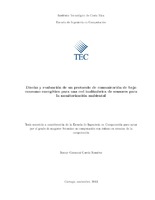Mostrar el registro sencillo del ítem
Diseño y evaluación de un protocolo de comunicación de bajo consumo energético para una red inalámbrica de sensores para la monitorización ambiental
| dc.contributor.advisor | Alvarado-Moya, Pablo | es |
| dc.contributor.author | García- Ramírez, Ronny Giovanni | |
| dc.date.accessioned | 2019-01-31T20:17:45Z | |
| dc.date.available | 2019-01-31T20:17:45Z | |
| dc.date.issued | 2013 | |
| dc.identifier.uri | https://hdl.handle.net/2238/10312 | |
| dc.description | Proyecto de Graduación (Maestría en Computación) Instituto Tecnológico de Costa Rica, Escuela de Ingeniería en Computación, 2013. | es |
| dc.description.abstract | This project consists on the design of the communication protocol used in a wireless sensor network to monitor variables in the forest; it covers protocol layer functions corresponding to the network, medium access control and data link layer according to the model of open systems interconnection (OSI) . Among the main problems faced in this project it is the reduction in the power consumed by the nodes compared with a node which implements IEEE802.15.4, obtain an acceptable latency in the transmission of information and to ensure that each network node has the ability to configure itself so that the modules do not have to be manually modified in the event of expansion or fails. A multilayered protocol for the transmission of alarms from network nodes to sink nodes is proposed. This protocol minimizes the number of hops for the frames in the network layer and uses data grouping to reduce network collisions and thereby reduce the energy waste associated with such collisions. Cycles where the transmission-reception module of the nodes is turned off are used and the improvement in power consumption due to such cycles is modeled and compared against a node which don’t use those turn-off cycles. The proposed protocol is evaluated for power consumption using as reference the network interface Texas Instruments CC2420 which uses the standard IEEE802.15.4, same standard used by ZigBee; for the reference node wiseroute was used as network protocol . The simulations are made using Omnet++ and the Mixim library. The tolerance of the protocol to changes is proven by tests designed using Omnet++. Tests are also carried out for power consumption and latency of the alarms from their occurrence at different levels of the network until they reach the base at different traffic and network levels while varying the duty cycle of the nodes. It is found that the proposed protocol is capable to provide approximately 90% energy savings in comparison to the reference nodes used, it is also capable of maintaining a mean latency of the alarms under 20 minutes for alarms that are generated 50 levels away from the sink nodes | es |
| dc.language.iso | spa | es |
| dc.subject | Consumo de energía | es |
| dc.subject | Energía eléctrica | es |
| dc.subject | Sensores | es |
| dc.subject | Protocolos de comunicación | es |
| dc.subject | Sistemas abiertos | es |
| dc.subject | Research Subject Categories::TECHNOLOGY::Electrical engineering, electronics and photonics::Electrical engineering | es |
| dc.title | Diseño y evaluación de un protocolo de comunicación de bajo consumo energético para una red inalámbrica de sensores para la monitorización ambiental | es |
| dc.type | info:eu-repo/semantics/masterThesis | es |
Ficheros en el ítem
Este ítem aparece en la(s) siguiente(s) colección(ones)
-
Maestría en Computación [107]


